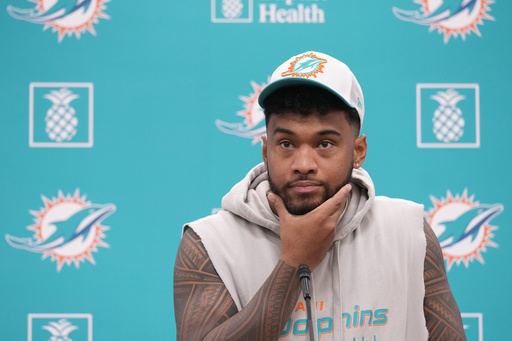
In Miami Gardens, Florida, the NFL has started to allow Guardian Caps, which are soft, protective coverings for helmets, to be worn by players during games this season. This initiative aims to help in mitigating incidents of head injuries within the league.
Although several players have donned these caps in the opening seven weeks of the season, Miami Dolphin’s quarterback Tua Tagovailoa mentioned on Monday that he will not wear the caps upon his return from a recent concussion. Players have cited various factors, such as comfort and appearance, as reasons for their reluctance to wear this protective gear.
Since 2022, the NFL has mandated that most players wear these caps during contact practices, with quarterbacks, kickers, and punters being the exceptions who are not required to wear them during such training sessions.
Furthermore, the league has approved six types of helmets that players can use in contact practices without the Guardian Caps.
Tua Tagovailoa has been cleared by medical professionals to return to the field after suffering his latest concussion following a hit from Bills defensive back Damar Hamlin during Week 2. If he successfully completes the NFL’s concussion protocols after practicing on Wednesday, he is anticipated to be back in action against the Arizona Cardinals this coming Sunday.
Here’s a detailed look at what the Guardian Caps are and their application within the NFL:
Guardian Caps are lightweight, padded shells weighing 12 ounces that attach to the top of a helmet. According to the NFL, research suggests that the use of this protective gear can decrease the severity of impacts by at least 10% when one player wears them. This reduction in impact severity can increase to at least 20% when both players involved in a collision use the caps.
It’s important to note that there is no headgear that can completely prevent concussions among NFL players.
This season, the NFL has also introduced eight position-specific helmets aimed at quarterbacks and linemen, although these helmets are not entirely concussion-proof. They are engineered to help minimize head trauma.
“As Dr. Allen Sills, the NFL’s chief medical officer, stated, ‘Anyone can experience a concussion in any helmet given the right impact.’ Our focus continues to be on reducing relative risks. A player who sports one of the top-performing helmets certainly lowers their chances of sustaining a concussion, which is supported by our lab and on-field analysis over the past eight years,” he explained.
The NFL recently reported the lowest number of concussions occurring during preseason since tracking began back in 2015. A total of 44 concussions were recorded during practice and games, representing a decrease of roughly 24% from the previous year. The introduction and usage of Guardian Caps were identified by league executive Jeff Miller as a contributing factor to this reduction.
Outside of the NFL, the Guardian Caps are also utilized by over 300 college programs, 3,000 high schools, and 750 youth programs across the United States.
